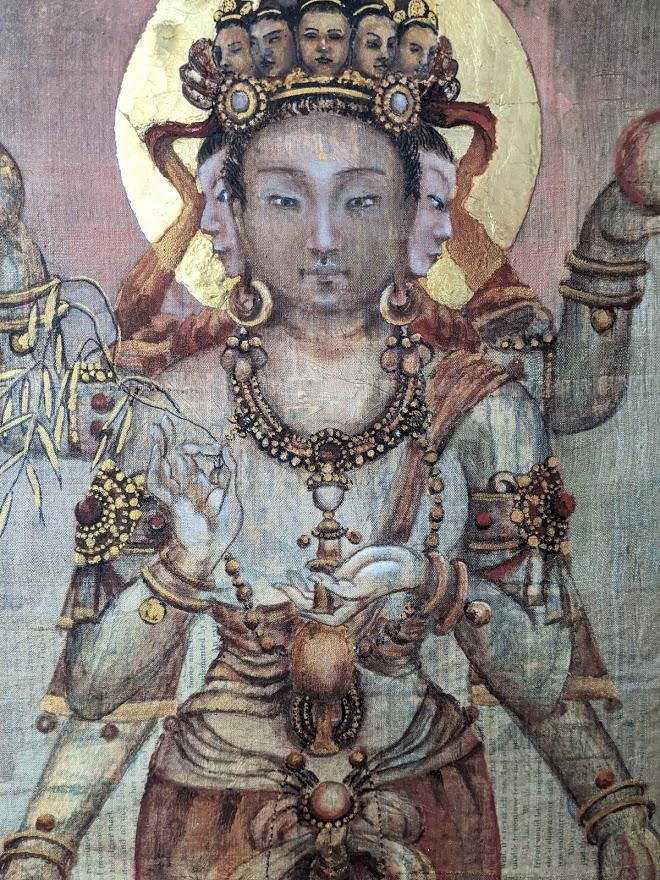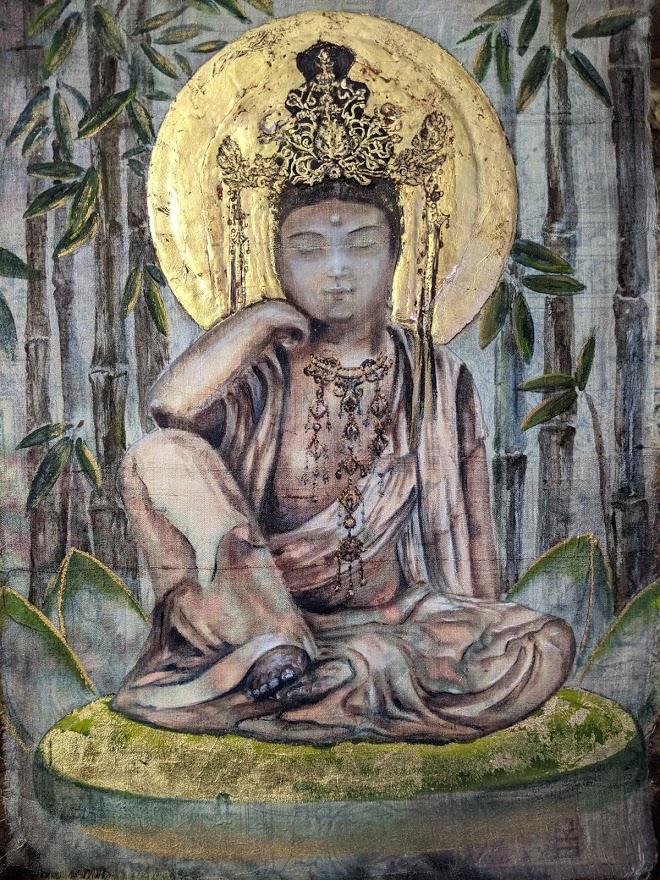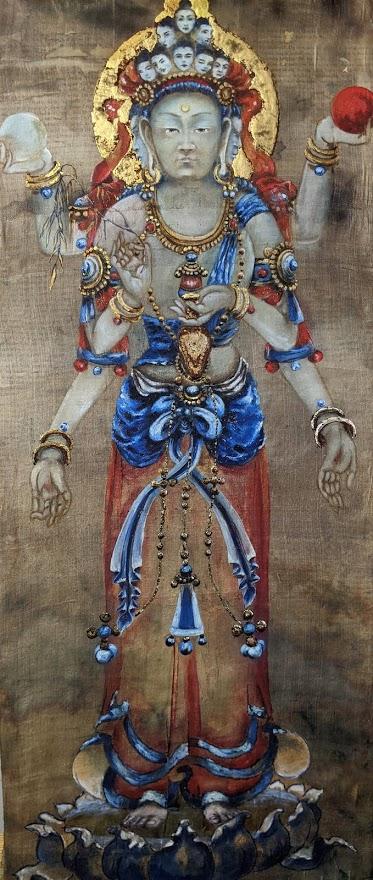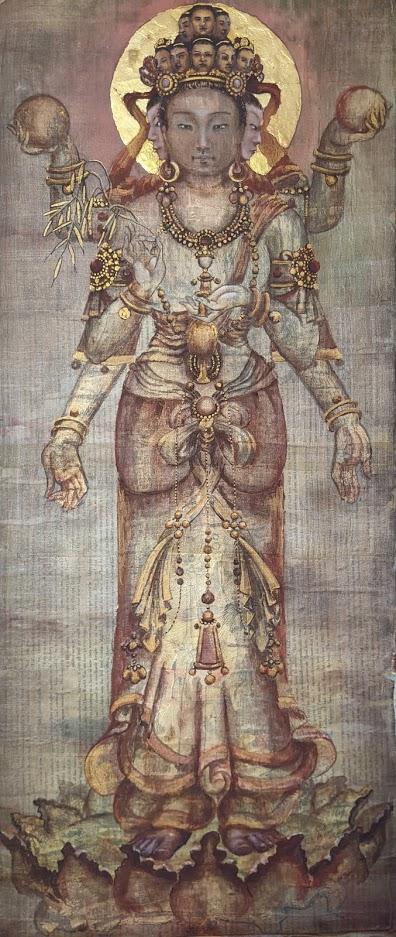FEATURES|COLUMNS|Silk Alchemy
Manifesting Avalokiteshvara: The Jewel within the Lotus

Painting by Tilly Campbell-Allen, based on the
Avalokiteshvara of late Tang period China
Auṃ Maṇi Padme Hūṃ
(The mantra of the jewel within the lotus)*
The Lotus Sutra of Mahayana Buddhism is the earliest text that teaches about Avalokiteshvara, who is revered in every branch of Buddhism, and is often seen with multiple arms and faces. The story tells of his pledge to help all sentient beings find liberation from suffering, and it is this desire that many argue is his bodhisattva nature rather than that of an actualized buddha. Avalokiteshvara vowed that he would shatter should he waver in this compassionate aspiration. One day, however, he did just that; Avalokiteshvara had noticed that however many sentient beings he helped to liberate, as many beings again suffered. The enormity of this quest would have felt impossible to bear, not merely a remarkably heavy burden. So Avalokiteshvara’s body shattered in accordance with his vow. Yet he was restored by his guru Amitabha; indeed, he can be considered a manifestation of Amitabha in earthly form. On this occasion, Avalokiteshvara was reformed with 1,000 faces, and 1,000 extra eyes upon each of his 1,000 hands, hence one of his many appellations is the Compassionate-eyed One.
Avalokiteshvara is known by other names: Chenrezig in Tibetan; Guanyin in Chinese; Kannon in Japanese. Jambhala, the god of wealth, is an emenation of Avalokiteshvara, as is even the fierce deity Mahakala. This places Avalokiteshvara as a buddha who can take form according to the needs of each person, rather than a bodhisattva. Avalokiteshvara arguably becomes whomever each of us needs at that particular moment. As is so often the case with most orthodox religions, the masculine is generally solely responsible for creation—not least of the universe—which has always seemed odd to me, but understandable given the societies that swept over the ancient pagan world. However, by the first century CE, he was becoming recognized as she in China in the form of Guanyin. Gender attribution may not seem important to some, and it may be subtle, but it is pervasive and influential in our relationship within ourselves as well as with the outer world. Just something to ponder over.

Painting on ahimsa silk by Tilly Campbell-Allen,
with 24-karat gold. Based on a gilded statue
of Nyoirin Cannon of the Japanese Edo period
Avalokiteshvara is said to be looking over us during this freewheeling time between the historical Shakyamuni Buddha and the buddha-to-come, Maitreya. Considered either the bodhisattva of compassion or a fully enlightened buddha, because according to some scholarly debate, Avalokiteshvara has chosen to delay becoming a buddha as he holds altruistic bodhicitta for the benefit of all, or an actual buddha who is, by nature, compassionate and fully enlightened. Well, that’s a very rudimentary explanation, but this is not an essay on the arguable semantics of buddhahood or bodhisattvahood, nor is it a rewrite of his stories, nor an academic study of the spread of his influence. Rather, it is a reflection of what he can mean in our own mundane lives.
When we recall the mantra Auṃ Maṇi Padme Hūṃ and what it pertains to, we are reminded of the treasure that exists within the lotus of our own being: that which arises through the fertile mud of the emotional waters and flourishes in full expression as it pierces through the water’s skin and blooms in the air and light of cosmic photons. Yes, that last term took something of a quantum mechanical turn. This is because, for me, it is a language and study that I rather enjoy. In fact, and somewhat ironically, it has actually given me something of a hook into the otherwise ineffable. I am reminded of the Prajñāpāramitā texts, the ultimate wisdom that reminds us of emptiness being form and form being emptiness. This is exactly what quantum physicists today tell us. The aforementioned photon is an elementary particle of radiant energy, in this case light. When we look at light, we take these photons into our bodies through our eyes. We take in photons when we eat real food that has grown outside and seen the seasons. In fact, our entire system emits a photon shimmer. Quantum physics tells us that reality is not what it seems and that we are “nothing” more than we are “something,” but that this “nothing” and “something” interact in ways that seem incomprehensible: for example that we “flicker” in and out of this known frequency all the time. We entangle in ways we don’t fully understand. Ninety-six per cent of the universe is unknown to us and the scientists refer to all this unknown as dark matter and dark energy. We are interacting with the universe in ways our intellect finds challenging.
Water has long been symbolic of the emotional realm. The jewel within ourselves we see as the transcendence from gross emotional experience to the conscious interplay with the subtle yet all-encompassing everything-ness of this “nothingness” of dark matter and dark energy. The jewel can also be thought of as something that flourishes within a lifespan. The “hero’s journey” of Joseph Campbell may be argued as the discovering of our inner jewel. A calling that opens us up like the lotus.
If we think of Avalokiteshvara as energy, then shapeshifting is as easy as air filling different shaped balloons. Avalokiteshvara’s appearance in one’s life therefore can feel like the appearance of someone or something manifesting in a form that we need most, or sending a message in a way that we recognize as significant. If Avalokiteshvara is an earthly guardian during the “in-between” chapters in life, much as Their Holinesses the Dalai Lama and the Karmapa are considered earthly manifestations of Avalokiteshvara looking after us during these Kali Yuga times, is it possible that this great guardian energy may make itself apparent to us in times of uncertainty, change, or distress?
After a long dry spell from creativity, I recently felt a sudden compulsion to paint Avalokiteshvara. I have painted many a Guanyin before, but this was the first time in this form, and the color and presence flooded in! It threw wide open a new creative door. The expression in that first painting felt genderless yet parental, and far from wishy-washy. I felt like I was being reprimanded, guided, and made safe, all at the same time. I was apparently the one painting, yet it all felt like a surprise to me!

Painting by Tilly Campbell-Allen, based on the
Avalokiteshvara of late Tang period China
Then came the next emanations as I painted more.
The same, yet so very different. Each with another message.

Painting by Tilly Campbell-Allen, based on the
Avalokiteshvara of late Tang period China
Are there moments in your life when you have felt this? Our aim may be to be of service but it’s not helping anyone when the cup is leaking. In a world full of pressures it’s easy to become wrapped up in the tightened grip of it all. A seedling holding on to its familiar muddied grounds in the perceived safety of dark murky waters.
But letting go? Imagine that. It means change as our budded flower breaks through into the light. We can still draw from the fertile wet earth that lies beneath the emotional waters, but to shine as we interplay with the light energy of the cosmos is where we bloom and contain the seeds for our future at the same time. This is a jewel, maybe not the ultimate jewel, but a jewel non the less, as most Buddhists know. It does not mean relaxing from effort, but it does come with a relaxed wry smile, feeling safe in the cradling arms of a loving parent.
* This well known Sanskrit mantra is particularly associated with the four-armed Shadakshari manifestation of Avalokiteshvara.
See more
Tilly Campbell-Allen (Dakini as Art)
Imaging of Ultraweak Spontaneous Photon Emission from Human Body Displaying Diurnal Rhythm (PMC)
Related features from Buddhistdoor Global
Guanyin and the Filial Parrot: An Emperor's Golden Offering
When Guanyin Jumps Off a Cliff
The Way of the Bodhisattvas
The Many Forms of Avalokiteshvara














